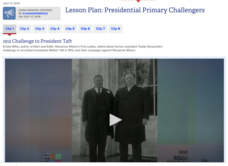iCivics
Mini-Lesson: Veto Power
No means no! Scholars analyze the impact of one of the president's most powerful tools—the veto—while also finding out ways to properly check facts for validity. They research the power of the presidential veto with paired activities and...
C-SPAN
Presidential Veto and Congressional Override
One of the key powers of the executive branch is the president's ability to pass or veto legislation proposed by Congress. Congress, the legislative branch, on the other hand, can override a president's veto. Five film clips show how the...
Curated OER
The Role of the Executive Branch in the Lawmaking Process
Young scholars examine Article I, Section 7, and Article II, Sections 2 and 3, of the U.S. Constitution, explain the president's role in the lawmaking process, and define the term veto.
Curated OER
All Those In Favor
Students share opinions about measures recently passed in their school, vote on and argue for and against hypothetical school policies, and respond to a "president's" decision to pass or veto the measures.
C-SPAN
The Role of the Executive Branch in Policy Making
Although the president of the United States does not have the power to pass laws, they can propose legislation, veto bills passed by Congress, and issue executive orders that bypass Congress. Six video clips show middle schoolers these...
Curated OER
How an Idea Becomes a Law
Students create posters that demonstrate the step-by-step process of how ideas become laws. They list the fourteen steps of a bill becoming a law, describe a presidential veto, and define override.
C-SPAN
How A Bill Becomes A Law
Seven steps are required for a bill to become a United States law. The Families First Coronavirus Response Act (H.R. 6201) is used as a model for the process of how a bill becomes a law. Class members work independently through a...
C-SPAN
Presidential Primary Challengers
A formidable opponent can shake up the election of an incumbent president. Class members explore the results of the elections of 1912, 1968, 1976, 1980 and 1992 using video clips. A chart helps pupils organize their thoughts and...
Curated OER
Ports in the Storm
Students explore national security issues related to the possibility of a Dubai-owned company operating an American port. Opinions are solicited and debated.
Curated OER
Representation: Majority rule
Students explore various forms of decision making including majority rule, executive, consensus and autocracy (as well as exploring the power of veto), when they debate a bill in a class parliament.
Curated OER
Andrew Jackson vs. The National Bank
Students explore Andrew Jackson's vision for the National Bank. In this Jackson presidency lesson, students determine why Jackson vetoed the National Bank's Charter and indentify the causes of the Panic of 1837.
National First Ladies' Library
The Education of Freedmen...and Women and Children
Pupils examine political debate surrounding Freedmen's Bureau, use primary sources to explore trials and successes of effort to educate newly-freed slaves of all ages, research reasons for creation of Freedmen's Bureau, discuss President...
Curated OER
The Executive Branch
Students identify the key terms and describe each one as it applies to the Executive Branch. Students identify and analyze the powers and duties of the president. Students discuss the Executive Branch in more detail, including the...
Curated OER
Writing and Amending Bills
Middle schoolers participate in a classroom Congress simulation. They research and write a bill, and enact the passing, amending, and vetoing process of taking a bill through the Committee process of Congress.
Curated OER
The Duties of Governments: Dix vs. Pierce
Students examine the role of Dorothea Dix on behalf of people with disabilities. They discuss President Pierce's veto of legislation she helped create. They address the rights and responsibilities of citizen's and the role of government.
Heritage Foundation
Lawmaking and the Rule of the Law
How many constitutional clauses does it take to create a bill? High schoolers find out with several activities and selected clauses about the rule of law and the US Constitution. Various coinciding activities help to strengthen...
American Bar Association
What Is Separation of Powers?
Who has the power? Scholars investigate the creation of the three branches of government in the United States Constitution. They analyze just why the framers created the branches the way they did.
Curated OER
The Role of the Judiciary in a System of Separation of Powers and Checks and Balances
Students determine the difference between the different branches of government and assess the role of each within the American governmental system.
Curated OER
The Role of the Judiciary in a System of Separation of Powers and Checks and Balances
Students determine the role of each branch of government in a system of checks and balances. They demonstrate the role of the judiciary in American government
Curated OER
Citizenship and the Constitution
Students identify government officials and resources on a local, state and national level. They determine the structure of local, state, and national governments.
Heritage Foundation
The Powers of the Executive
Are executives as powerful as they sound? High schoolers find out about the US president and executive branch. A variety of activities include scaffolded reading sections, research assignments, and collaborative group work.
National Constitution Center
Separation of Powers
Learners explore how the Constitution provides for separation of power and limited government, as evidenced by the three branches of government. They participate in role-playing situations, group discussions, and complete worksheets to...
C-SPAN
Middle School Checks and Balances
Seven video clips reveal how the checks and balances built into the constitutional framework of the United states' government are designed to keep any one branch from becoming too powerful. After watching each clip, groups identify the...
Curated OER
Representation: Majority Rule
Students explore government. In this decision making instructional activity, students discover the importance of majority rule in the passing of bills. They all participate in a class debate and practice the different forms of decision...























